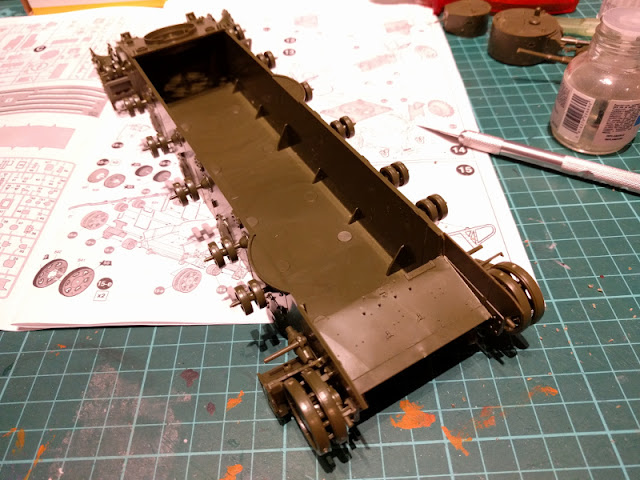The final construction post
This is the last post about the building part, trust me. I think I'll keep the same naming up until this is all done.Side armour plates
To begin the end of this, I started by cutting off the left side's armour skirt pieces and cleaning them up from excess crap. Then I simply glued them on to the support structure, starting from the front.No major problems occurred, other than that the armour skirts didn't just reach the deck armour at all. I did complain earlier that there were fitting issues between the deck and the tub. Here those just glared at you, as the top attatchment points of the plates didn't hit. Looking a bit further away (image 2) it didn't look too bad, but still.
The other half of the tank went just as quickly, with the same issues. I'd have to use a full session at least to putty and whoknowhowelse to fix these random things. That was going to be a post on its own, I didn't want to mix that stuff here this time.
The cable roll
My last missing piece was the cable roll, that was going to be installed to the left side of the turret cluster. I just superglued one end of the thread to the core and left it hanging. My idea was that I'd paint the roll separately and only after that and the tank were painted, I'd roll up the thread, superglue a bit near the end, cut the excess away and then glue the setup on the deck. There was enough thread for a couple of these, based on a very quick test.The point of doing this in this order was that it wouldn't matter if and when the thread got painted on, as the ruined part of it would be hidden in the center of the roll. And the outer side would be weathered just like everthing else. As the thread's colour was just fine in my opinion, I wasn't going to paint it at all.
Schedule mumblings
At this point, when all the actual building was done and the hours locked in, I thought I'd ponder a bit on the numbers. So, I had 14 * 45 mins + this post's fifteen minutes (amazingly quick, I know!) clocked. That totaled in at 645 mins, that then turned into a slightly prettier form: 10h 45min.Interesting, I'd say, especially as a number of earlier projects, where I've been marking down my hours (in a different way, but still) have been completely finished with these numbers. Those have all had a pretty small percentage spent on the actual building out of the whole project.
Where did all this time go, then? As we all know, a context switch is an expensive operation, and this is what has been going on a lot: 15 times starting up + doing something + wrapping up. So there's been a lot of repetition and sort of "extra" time. But a big reason for my suboptimal time usage was that my hobbying environment has changed quite a lot from what they were, say, a year ago. These 45min sessions have not been exactly full of 100% concentration, but that's life for you :)
I guess that if all my modeling projects were done in an NTP environment, they could be compared plausibly, but the real world has never behaved that way. Different models, makers and who knew what other variables were in play, all those have affected the time spent in each stage in curiously varied ways. I really wasn't going to build a dozen different versions of the same model just to get some data on this, so... yeah, this was a long build while others haven't been :p




















































